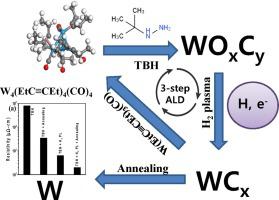Applied Surface Science ( IF 6.3 ) Pub Date : 2021-11-29 , DOI: 10.1016/j.apsusc.2021.152062 Jin-Hyeok Lee 1 , Romel Hidayat 2 , Rahul Ramesh 1 , Hyeonsu Roh 2 , Dip K. Nandi 1 , Won-Jun Lee 2 , Soo-Hyun Kim 1

|
This article reports the preparation of tungsten metal (W) and other tungsten-based thin films using a F-free W metalorganic precursor tris(3-hexyne) mono-carbonyl tungsten [W(EtC CEt)3(CO)] (Et = C2H5), THMCT], tert-butyl hydrazine (TBH), and H2 plasma via 2- and 3-step atomic layer deposition (ALD) process. Density functional theory (DFT) calculations were performed to simulate the possible mechanisms of W4(EtC
CEt)3(CO)] (Et = C2H5), THMCT], tert-butyl hydrazine (TBH), and H2 plasma via 2- and 3-step atomic layer deposition (ALD) process. Density functional theory (DFT) calculations were performed to simulate the possible mechanisms of W4(EtC CEt)4(CO)4, as the model of chemisorbed THMCT on the growing surface, with TBH. The experimental findings agree well with the DFT results that the thermal ALD of THMCT and TBH could not deposit the pure W metal films. Instead, THMCT and TBH led to form an amorphous, tungsten oxycarbide, WOxCy (with a minor nitrogen content and a negligible amount of W metal phase), resulting in a very high resistivity of ∼80,000 μΩ-cm (at 300 °C). Nevertheless, the typical characteristics of ALD, such as the self-limiting growth, and a linear dependency of the film thickness with cycle variation, were obtained with a growth-per-cycle (GPC) of ∼0.4 Å. Post-annealing of the films in the H2 atmosphere resulted in a slight increase in the metallic phase formation with a significant drop in resistivity to ∼3500 μΩ-cm. However, the annealing also facilitated the formation of the tungsten oxide phase owing to the oxygen incorporated in the as-deposited films. Introducing an additional H2 plasma pulse step at the end of each ALD cycle (3-step ALD process) significantly altered the film composition and helped reduce the as-deposited film's resistivity drastically to ∼650 μΩ-cm. Also, the process results in the formation of tungsten carbide (WCx) as the predominant phase. Finally, the additional high-temperature-post-annealing of these 3-step ALD grown films resulted in extremely low resistivity of ∼200 μΩ-cm owing to the formation of body-centered-cubic (BCC) α-W. Thus, the envisaged path in this study to achieve W thin films also provides rooms to grow oxide or carbide dominant phase of W as studied in detail with the help of X-ray photoelectron spectroscopy
CEt)4(CO)4, as the model of chemisorbed THMCT on the growing surface, with TBH. The experimental findings agree well with the DFT results that the thermal ALD of THMCT and TBH could not deposit the pure W metal films. Instead, THMCT and TBH led to form an amorphous, tungsten oxycarbide, WOxCy (with a minor nitrogen content and a negligible amount of W metal phase), resulting in a very high resistivity of ∼80,000 μΩ-cm (at 300 °C). Nevertheless, the typical characteristics of ALD, such as the self-limiting growth, and a linear dependency of the film thickness with cycle variation, were obtained with a growth-per-cycle (GPC) of ∼0.4 Å. Post-annealing of the films in the H2 atmosphere resulted in a slight increase in the metallic phase formation with a significant drop in resistivity to ∼3500 μΩ-cm. However, the annealing also facilitated the formation of the tungsten oxide phase owing to the oxygen incorporated in the as-deposited films. Introducing an additional H2 plasma pulse step at the end of each ALD cycle (3-step ALD process) significantly altered the film composition and helped reduce the as-deposited film's resistivity drastically to ∼650 μΩ-cm. Also, the process results in the formation of tungsten carbide (WCx) as the predominant phase. Finally, the additional high-temperature-post-annealing of these 3-step ALD grown films resulted in extremely low resistivity of ∼200 μΩ-cm owing to the formation of body-centered-cubic (BCC) α-W. Thus, the envisaged path in this study to achieve W thin films also provides rooms to grow oxide or carbide dominant phase of W as studied in detail with the help of X-ray photoelectron spectroscopy
中文翻译:

使用无氟钨前驱体和叔丁基肼通过 2 步和 3 步原子层沉积工艺制备钨基薄膜
本文报道了使用无 F W 金属有机前体三(3-己炔)单羰基钨 [W(  EtC CEt) 3 (CO)] (Et = C 2 H 5 )、THMCT]、叔丁基肼 (TBH) 和 H 2等离子体,通过 2 步和 3 步原子层沉积 (ALD) 工艺。进行密度泛函理论 (DFT) 计算以模拟 W 4 (
EtC CEt) 3 (CO)] (Et = C 2 H 5 )、THMCT]、叔丁基肼 (TBH) 和 H 2等离子体,通过 2 步和 3 步原子层沉积 (ALD) 工艺。进行密度泛函理论 (DFT) 计算以模拟 W 4 (  EtC CEt) 4 (CO) 4的可能机制,作为生长表面上化学吸附 THMCT 的模型,具有 TBH。实验结果与 DFT 结果非常吻合,即 THMCT 和 TBH 的热 ALD 无法沉积纯 W 金属薄膜。相反,THMCT 和 TBH 导致形成无定形碳氧化钨 WO x C y(具有少量氮含量和可忽略不计的 W 金属相),导致非常高的电阻率约为 80,000 μΩ-cm(在 300 ° C)。尽管如此,ALD 的典型特性,例如自限性生长,以及薄膜厚度与循环变化的线性相关性,是通过每循环生长 (GPC) 为 ~0.4 Å 获得的。H 2 中薄膜的后退火大气导致金属相形成略有增加,电阻率显着下降至~3500 μΩ-cm。然而,退火也促进了氧化钨相的形成,因为在沉积膜中掺入了氧。在每个 ALD 循环(3 步 ALD 工艺)结束时引入额外的 H 2等离子体脉冲步骤显着改变了薄膜成分,并有助于将沉积薄膜的电阻率大幅降低至 650 μΩ-cm。此外,该过程会形成碳化钨 (WC x) 作为主要阶段。最后,由于形成体心立方 (BCC) α-W,这些 3 步 ALD 生长膜的额外高温后退火导致了约 200 μΩ-cm 的极低电阻率。因此,本研究中设想的实现 W 薄膜的路径也为生长 W 的氧化物或碳化物主相提供了空间,正如在 X 射线光电子能谱的帮助下详细研究的那样
EtC CEt) 4 (CO) 4的可能机制,作为生长表面上化学吸附 THMCT 的模型,具有 TBH。实验结果与 DFT 结果非常吻合,即 THMCT 和 TBH 的热 ALD 无法沉积纯 W 金属薄膜。相反,THMCT 和 TBH 导致形成无定形碳氧化钨 WO x C y(具有少量氮含量和可忽略不计的 W 金属相),导致非常高的电阻率约为 80,000 μΩ-cm(在 300 ° C)。尽管如此,ALD 的典型特性,例如自限性生长,以及薄膜厚度与循环变化的线性相关性,是通过每循环生长 (GPC) 为 ~0.4 Å 获得的。H 2 中薄膜的后退火大气导致金属相形成略有增加,电阻率显着下降至~3500 μΩ-cm。然而,退火也促进了氧化钨相的形成,因为在沉积膜中掺入了氧。在每个 ALD 循环(3 步 ALD 工艺)结束时引入额外的 H 2等离子体脉冲步骤显着改变了薄膜成分,并有助于将沉积薄膜的电阻率大幅降低至 650 μΩ-cm。此外,该过程会形成碳化钨 (WC x) 作为主要阶段。最后,由于形成体心立方 (BCC) α-W,这些 3 步 ALD 生长膜的额外高温后退火导致了约 200 μΩ-cm 的极低电阻率。因此,本研究中设想的实现 W 薄膜的路径也为生长 W 的氧化物或碳化物主相提供了空间,正如在 X 射线光电子能谱的帮助下详细研究的那样











































 京公网安备 11010802027423号
京公网安备 11010802027423号